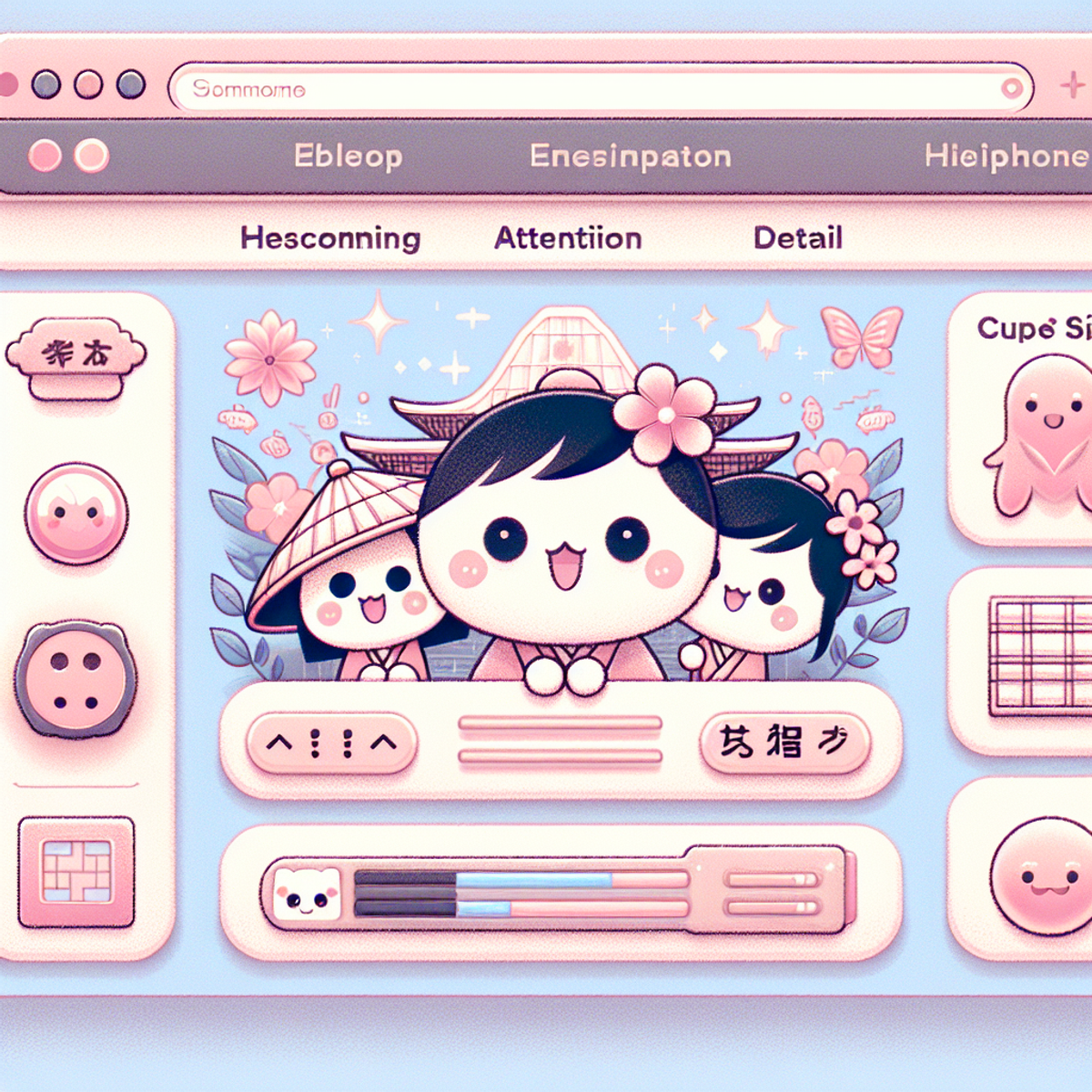
Introduction
The unique characteristics of Japanese web design play a significant role in shaping marketing strategies in Japan. Websites in Japan are usually packed with text, providing detailed information, testimonials, and statistics. They also tend to use soft, muted colors inspired by traditional aesthetics and nature. Cute characters and 2D illustrations are commonly found on these websites, creating a friendly atmosphere.
When it comes to marketing in Japan, localization is key. Japanese consumers have high standards and are often skeptical of new brands. They value verification and trustworthiness. To succeed in this market, businesses must understand these traits and tailor their approach accordingly.
In this article, we will explore the following topics:
- Understanding Japanese Web Design: We’ll examine the defining features of Japanese web design.
- Importance of Localization for the Japanese Market: Here we explore why localization is crucial when targeting the Japanese market.
- Adapting Brand Identity and Positioning to Appeal to Japanese Consumers: We’ll discuss how to adjust your brand’s identity to resonate with the Japanese market.
- Effective Strategies for Website Localization in Japan: This section examines how website localization goes beyond language translation.
- The Localization Process for Japanese Websites: We’ll provide key steps for localizing your website for the Japanese context.
- Choosing the Right Approach for Your Brand’s Expansion into Japan: Finally, we consider how to select the most suitable approach for bringing your brand to the Japanese market.
By gaining an understanding of Japanese web design, marketing, and localization, you will be better equipped to adapt your brand and business strategies to successfully enter this unique market.
Understanding Japanese Web Design
Japanese web design is distinct, reflecting the country’s unique aesthetic and cultural values. Key features include:
1. Text-Heavy Layouts
Websites in Japan often present dense text blocks, providing exhaustive information that caters to the local audience’s desire for detail and verification.
2. Abundance of Information
It’s common to find pages filled with data, testimonials, and statistics. This aligns with the consumer traits of skepticism and a high standard for quality, ensuring a comprehensive understanding of products or services.
3. Cute Characters and 2D Illustrations
These elements serve more than just an aesthetic purpose; they create a friendly atmosphere and contribute to brand uniqueness. The use of mascots or characters can be seen across corporate websites to e-commerce platforms.
4. Soft Muted Colors
Inspired by traditional Japanese aesthetics and nature, soft palettes convey a sense of calmness and are preferred over harsh or bright colors in web design.
Understanding these design preferences is not merely an exercise in aesthetics but a strategic marketing imperative. When you align your brand’s online presence with these design traits, you significantly increase your chances of resonating with the Japanese market.
Importance of Localization for the Japanese Market
Localization in Japan is not just about translating content; it’s a crucial strategy to connect with unique consumer traits. Japanese market dynamics are influenced by consumers who:
- Skepticism: They tend to thoroughly examine new products and brands before accepting them.
- Insistence on verification: They prefer having plenty of evidence such as detailed information, testimonials, and statistics that support businesses’ claims.
These characteristics highlight the importance of using localized marketing approaches specifically tailored to Japanese consumers. When you localize for Japan, you’re committing to meeting the high standards that this discerning audience expects. To fulfill these expectations, every aspect of your brand’s localized experience must demonstrate excellence — from website design and user interface to customer service and product quality. Only then can a brand hope to earn the trust and loyalty of Japanese customers.
Adapting Brand Identity and Positioning to Appeal to Japanese Consumers
When entering the Japan market, it is essential for brands to refine their identity, image, positioning, and personality to align with the expectations and preferences of Japanese consumers. Here’s how you can adapt your brand for Japan market entry:
1. Catering to Domestic Preference
Emphasize elements that cater to the preference for domestic brands by providing marketing materials that are not only informative but also impeccably presented. Case studies and testimonials can be particularly effective.
2. Detailed Product Information
Since Japanese consumers value detailed product information, ensure your brand’s offerings are accompanied by extensive specifications and explanations to foster trust.
3. High Quality Presentation
The online presence of your brand must reflect the high-quality standards expected in Japan. This includes a meticulous website design that prioritizes aesthetics and functionality.
4. Conformity vs Uniqueness
Japanese culture leans towards collectivism, valuing harmony and conformity. Yet, there is room for brands to stand out by highlighting unique selling propositions without disrupting societal norms.
5. US Brands Strategy
For US brands targeting the Japanese market, it’s beneficial to strike a balance by emphasizing both freedom—a tenet valued in Western culture—and uniqueness in a way that appeals to Japanese tastes and values.
By integrating these strategies into your brand’s approach when entering the Japanese market, you can better resonate with local consumers while maintaining your brand’s core values.
Effective Strategies for Website Localization in Japan
When expanding your brand into Japan, simply translating the language is not enough. It’s important to have a deep understanding of the design preferences in the target country. A successful Japanese website localization strikes a balance between staying true to the original brand and adapting to suit local tastes. Here are some effective strategies to keep in mind:
1. Comprehend Design Preferences
Integrate design elements that are favored by Japanese users, such as:
- Text-heavy layouts
- Muted color palettes
2. Balance Between Original and Local
Maintain your brand’s core identity while adapting certain aspects to fit Japanese aesthetics and meet user expectations.
3. Localized User Engagement
Tailor your content to encourage user interaction, which can lead to improved engagement metrics. This can be done through:
- Creating culturally relevant quizzes or polls
- Incorporating user-generated content that resonates with Japanese audiences
- Implementing features like live chat support with Japanese-speaking agents
4. Conversion Optimization
Customize your call-to-actions (CTAs) and user journey paths to align with Japanese cultural nuances, potentially increasing conversion rates. Some examples include:
- Using localized language and references in CTAs
- Offering payment methods that are commonly used in Japan
- Providing clear product information and specifications, as Japanese consumers tend to value detailed descriptions
5. Boost Online Presence
Localized content has a higher chance of ranking well on local search engines, thus improving your online visibility within Japan. Consider these tactics:
- Conducting keyword research specifically for the Japanese market
- Creating region-specific landing pages with optimized content
- Building backlinks from reputable Japanese websites
6. Build Reputation and Trust
Having a culturally relevant website helps foster trust among Japanese consumers, which is essential for establishing brand credibility. Here’s how you can achieve this:
- Showcasing testimonials or reviews from Japanese customers
- Highlighting partnerships with well-known Japanese brands or influencers
- Including certifications or awards that are recognized in Japan
7. Enhance SEM Efforts
If you’re running search engine marketing (SEM) campaigns in Japan, it’s crucial to adapt your approach to align with how Japanese consumers search and interact online. Consider these tactics:
- Using localized keywords that are relevant to your target audience
- Crafting ad copy that resonates with Japanese cultural values or trends
- Testing different ad formats (e.g., display ads, video ads) to see which performs best in the Japanese market
By implementing these strategies, you’ll be able to position your brand for greater success in the competitive Japanese market.
The Localization Process for Japanese Websites
Website localization for the Japanese market demands more than a simple translation; it is a meticulous process that respects the unique web design principles and consumer expectations of Japan. Key aspects such as Japanese web design features illustrations manga cute visuals smaller graphics add a layer of complexity to the localization process.
Key Considerations for Website Localization in Japan
Here are some important factors to keep in mind when localizing a website for the Japanese audience:
1. Use of Illustrations and Visuals
Japanese websites often feature an array of visual elements including manga-style drawings, cute mascots, and finely detailed graphics. These not only capture attention but also convey messages in a way that resonates with the local audience. Integrating these elements can be a game-changer for foreign brands looking to appeal to Japanese users.
2. Cultural Understanding in Copywriting
Effective localization isn’t just about translating content; it’s about crafting messages that feel native to the audience. Japanese copywriting requires cultural understanding and localization expertise to ensure nuances and subtleties are not lost in translation. This includes the use of appropriate honorifics, idiomatic expressions, and culturally relevant references.
3. Content Length for SEO
When considering search engine optimization (SEO), the optimal content length for SEO in Japanese is 1,600-2,000 words. This ensures that web pages have enough informative content to rank well on search engines like Google Japan while providing significant value to readers.
The Localization Process
The localization process includes defining scope keyword research translation localization measurement optimization, which encompasses:
- Defining Scope: Establishing clear objectives and identifying the extent of needed localization.
- Conducting Keyword Research: Analyzing which keywords are most effective for engaging the Japanese audience.
- Implementing Changes: Applying linguistic adaptations alongside design adjustments to reflect Japanese preferences.
- Ongoing Measurement/Optimization: Continually reassessing website performance and making improvements based on user feedback and analytics data.
By following these steps, businesses can ensure that their localized website aligns with the expectations of Japanese consumers, laying a solid foundation for success in this distinctive market.
Choosing the Right Approach for Your Brand’s Expansion into Japan
Deciding on an approach for your brand expansion in Japan requires careful thought. A myriad of factors come into play, including your budget, business objectives, and available resources.
Here are a few considerations:
- Budgetary Constraints: Not all strategies require the same level of investment. You might opt for lightweight localization or a complete website refresh depending on what you can afford.
- Business Objectives: If your goal is to build long-term relationships with Japanese customers, investing more in comprehensive localization may be beneficial. Conversely, if your aim is simply to test the market, a less involved strategy might suffice.
- Internal Capabilities: Evaluate your team’s skills. Do you have in-house experts who understand Japanese culture and language? If not, partnering with a creative marketing company skilled in Japanese markets could be advantageous.
Remember that there’s no one-size-fits-all answer. The choice depends largely on your organization’s context, capabilities, and expectations. Make sure to tailor your approach to align with these factors to increase the likelihood of your success in Japan.
Conclusion
To succeed in the Japanese market, brands must:
- Embrace Japanese web design principles
- Implement effective localization strategies
- Adapt marketing approaches to suit local preferences
Japanese web design is characterized by:
- Text-heavy layouts
- Muted colors
- Cute visuals
Understanding these cultural aesthetics is crucial as they influence consumer behavior. The key to success lies in how well a brand can navigate these intricate details.
Creating an impactful online presence requires more than just translating content. It involves:
- Thoughtful marketing efforts
- Localization beyond language
- Crafting websites that cater to Japan’s design preferences and quality standards
This demonstrates a brand’s dedication to this dynamic market.
When entering the Japanese market, brands should consider:
- The influence of collectivist culture on consumer expectations
- How individualistic traits can differentiate a brand
By leveraging the insights from this article, brands can develop a culturally attuned approach and ensure their website embodies the nuances of Japanese digital etiquette.
Establishing a strong brand presence in Japan may be challenging, but it offers valuable opportunities to engage with one of the world’s most sophisticated audiences.
Remember these key principles:
- Aim for authenticity
- Prioritize quality
- Strive for cultural resonance
By doing so, brands can position themselves for long-term success.

